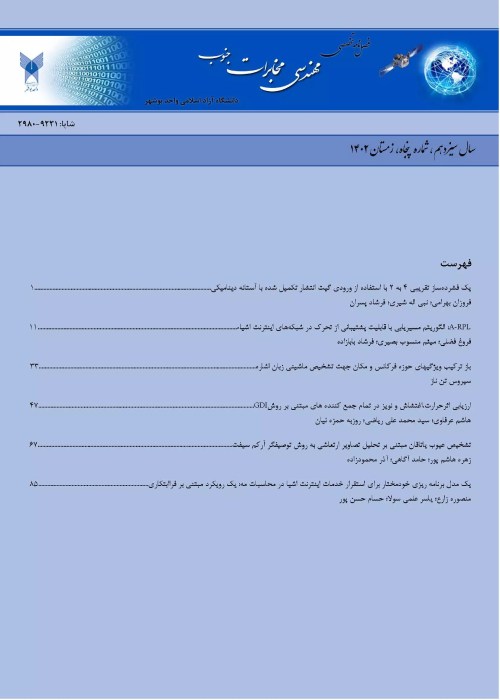فهرست مطالب
نشریه مهندسی مخابرات جنوب
پیاپی 18 (زمستان 1394)
- تاریخ انتشار: 1394/08/14
- تعداد عناوین: 1
-
صفحات 7-13
فرآیند معماری سازمانی چابک پیچیده بوده و معمار می تواند برای کنترل پیچیدگی آن، از چارچوب به عنوان تنظیم کننده ساختار و از سبک به عنوان جهت دهنده به رفتار استفاده کند. یکی از نیازهای غیروظیفه مندی در معماری سازمانی چابک، کارایی می باشد و یکی از پارامترهای کارایی سیستم، زمان پاسخ می باشد که در این تحقیق از آن استفاده شده است. بدین جهت و برای ایجاد نظم و سازماندهی توصیفات معماری سازمانی استفاده ازیک چارچوب الزامی می باشد. هدف از این مقاله ارایه روشی برای ارزیابی کارایی معماری سازمانی چابک، جهت دستیابی به یک معماری خوب و مناسب می باشد. در این تحقیق با بهره گیری از چارچوب هایی که مبنای آن ها چارچوب زکمن می باشد، ابتدا ویژگی های سازمان مورد نظر را با استفاده از نمودارهای UML بیان می شود. در ادامه این نمودارها که عمدتا به صورت رفتاری و ساختاری می باشد به مدل های رسمی تبدیل می گردد. کلیشه های مربوط به UML که به صورت حاشیه نگاری برروی نمودارهای UML قرار می گیرند در این راستا مورد استفاده قرار خواهند گرفت. امکان ارزیابی نیازهای غیروظیفه مندی برروی مدل های رسمی فراهم می گردد. نتایج تحقیق نشان می دهد که با ارایه یک مدل، در فاز طراحی از هزینه های سنگین فاز پیاده سازی اجتناب می گردد.
کلیدواژگان: معماری سازمانی چابک، زبان مدلسازی یکپارچه، شبکه پتری، چارچوب DODAF
-
Pages 7-13
Agile enterprise architecture is developed in a process called enterprise architecture process. This process is complex and the architect can use a framework to regulate its structure and use a style to guide its behavior in order to control its complexity. In architecture, behavior precedes structure and with a structure, it is possible to have various behaviors. One of the factors with which, one can determine which one of these behaviors is more appropriate for agile enterprise architecture, is architecture performance assessment. A non-functional requirement in agile enterprise architecture is efficiency, and one of the system efficiency parameters is response time which has been used in this research. For this purpose, and in order to regulate and organize enterprise architecture descriptions, it is necessary to use a framework. DODAF, unlike Zachman framework which has six viewpoints, consists of three different viewpoints. Unified Modeling Language (UML), makes it possible that the products of this framework, be shown with a unified modelling symbol. The aim of this research is to provide a method to assess the efficiency of agile enterprise architecture to achieve a proper architecture. In this research, using Zachman-based frameworks, first, the characteristics of the desired enterprise are described using UML diagrams. In the following, these diagrams which are mainly behavioral and structural, are turned into official models. UML-related clichés which are usually placed as marginal graphics on UML diagrams will be used for this purpose. It will be possible to assess non-functional requirements on official models. In the proposed method, we will assess the efficiency of agile enterprise architecture in the design and pre-implementation phases. Research results show that with the provision of a model in the design phase, heavy implementation costs will be avoided.
Keywords: Agile enterprise architecture, Unified modeling language (UML), Petri nets, DODAF


